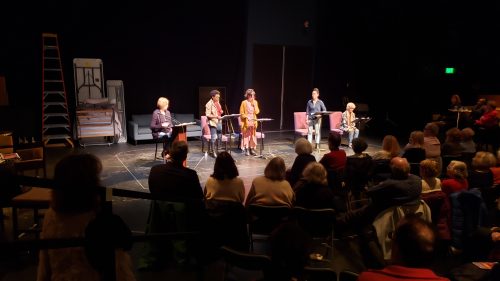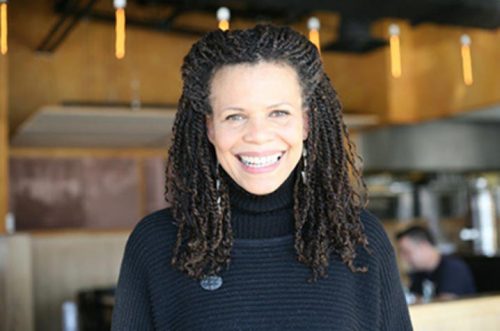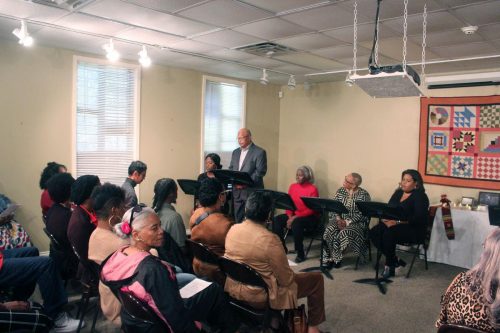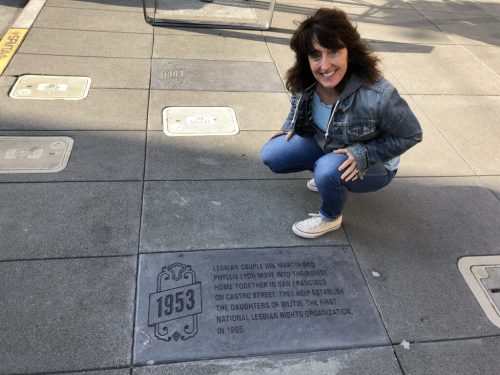
Reading of ALABASTER, by Audrey Cefaly, at the Everyman Theatre on December 9, 2019, part of a Salon Series Reading of ALABASTER at the theatre in Baltimore, MD. Directed by Beth Hylton.

Reading of ALABASTER, by Audrey Cefaly, at the Everyman Theatre on December 9, 2019, part of a Salon Series Reading of ALABASTER at the theatre in Baltimore, MD. Directed by Beth Hylton.
Ifa Bayeza works with students in New Iberia LA to research the full history of New Iberia. She was commissioned by the National Historic Trust.

Shadows-on-the-Teche held a community writing workshop Saturday that gave a sneak preview of the dramatic work “First Light.”
Led by Ifa Bayeza, who had previously worked on “Bunk Johnson Out of the Shadows!,” a production presented by Shadows-on-theTeche, the work took place at the Shadows Visitors Center with a full room of interested attendees.
Bayeza was chosen by the National Trust for Historic Preservation to present a play about New Iberia jazz trumpeter Bunk Johnson, and was chosen again for “First Light.”
The piece is part of a larger effort called “Telling the Full History,” which will be released next year. The work was filled with people involved in the workshop who took part in the dramatic piece.

The big news of the day, delivered to your inbox every weekday and Sunday afternoon. This comes with the Weekly Wrap, a curated digest of stories delivered Friday evenings.
“First Light” presents African-American experiences in New Iberia, from its African, Native American and European roots to the Civil Rights Movement.
Participants in the workshop included Charles Porter, Kelly Porter, Elton Broussard Jr. Jackie Reedom, Mary Margaret Bell and Phebe Hayes. The hour-long event Saturday was presented in five movements.
“Telling the Full History” showcases homegrown talent and the traditions, cultural impact and history of New Iberia’s black neighborhoods and families in an original performance to be presented in September 2020 at The Shadows.
The full article available by Corey Vaughn from the Daily Iberian here.
“Strange.” “Weird.” “Exotic little beauty.” “Like something from another world.”
These are ways in which the plant of “Little Shop of Horrors” is initially described by its characters. They’re perplexed by its presence, its mysterious origins, its unidentifiable genus. But the botanical fascination is so enticing that it boosts the business of a skid row flower shop — and convinces its caretaker to commit a bit of murder in exchange for fame and fortune.
Countless stagings of the Howard Ashman-Alan Menken musical have remained visually devout to the sprout that debuted off-off-Broadway in 1982. Based on the 1960 Roger Corman cult classic and popularized by Frank Oz’s 1986 musical film, the Faustian fable has been mounted again and again with a green, podlike growth resembling a Venus flytrap and a bountiful head of lettuce.
“The classic look can be nostalgic but also predictable,” said Mike Donahue, who directed the Pasadena Playhouse production set to close Sunday. “All of the language that’s in the piece is about how the plant stands out, how it catches people’s eyes immediately when people are walking by. There’s gotta be something about it that, in this drab and depressed and bleak world, just pops.” Advertisement
The Playhouse questioned those optical expectations and answered with a radical redesign of the plant, Audrey II, nicknamed Twoey. Housed in a large tomato can, its flower is a fantastic fuchsia hue, the five appendage-like tendrils glistening and sparkling. When closed, a bud of polka dot petals resembles a head with lips. It opens into a lily with a playful yellow tongue. This Twoey is indeed a new sight for those onstage and in the audience, and now that the run is ending, her secrets are being revealed in new photos presented exclusively here.
“I wanted to make something that seems alien and extraterrestrial but also that gives an emotional reaction — you can’t help but smile,” said Sean Cawelti, who led the show’s puppet design, direction and choreography. “And when the plant opens its petals for the first time and reveals what’s inside, it’s not inherently scary but surprisingly whimsical and magical.”

Fear is the furthest thing from anyone’s mind during the song “Grow for Me.” A first version of Twoey — which “faints” via remote control — is swiftly swapped for a rod puppet plant with hard-to-spot cables controlled by three puppeteers under a metal table.
Read the full review by Ashley Lee from the LA Times here.

Not far from where playwright Patricia Cotter lives in the Castro District, a bronze plaque in the sidewalk reads: “1953: Lesbian couple Del Martin and Phyllis Lyon move into their first home together in San Francisco on Castro Street. They help establish the Daughters of Bilitis, the first national lesbian rights organization, in 1955.”
Just a few blocks away, on 19th Street, is where the Lexington Club, affectionately known as the Lex, served cheap drinks from 1997 to 2015, when its closure marked the end of the last lesbian bar in San Francisco.

These two chapters of local lesbian history comprise the two acts of “The Daughters,” Cotter’s comedy whose San Francisco Playhouse Sandbox Series world premiere runs through Nov. 2 at the Creativity Theater. The Chronicle met with Cotter at Spike’s Coffee and Teas, also on 19th Street, to talk about the arc of history she traces in the show.
Q: What was the initial impulse behind “The Daughters”?
A: I think it was really at the closing of the Lex, which, honestly, wasn’t my bar. I had come to San Francisco later, so by the time I got here that wasn’t my coming up and coming out, going to the Lex. But it seemed like an icon leaving, its closing.

Q: What gave you that feeling?
A: It was a lot of women I know really grieving that it was closing. And then it’s like, “When was the last time you were there?” “Seven years ago, eight years ago.” … So if we’re not going — but then also the question, “Do we need it? Do we need a lesbian bar?” Because any bar can be a lesbian bar; it doesn’t specifically have to be one. But there’s something lost when you know this is the place where you’re going to be welcome.
I would have people in this neighborhood say to me, travelers, “Where’s the closest lesbian bar?” There isn’t one. Actually, there’s tons of queer bars, but (not one) specifically where you know it’s your place, where it’s created for you.
I think when (the Lex) closed, it got me thinking about lesbian history. I hadn’t really seen my history anywhere. I knew about Phyllis and Del. (They were the first legally married same-sex couple in California in both 2004 and 2008.) The play isn’t at all a biography of Phyllis and Del. It’s more of a tribute to the women who changed the world — in a room, at a party.

I was just so impressed with the risks they took. The women who started the Daughters were so different from each other. That’s all they had in common: that they were gay, that they wanted to meet other gay women, either to date or to just have friends, and they couldn’t do it in bars. They could, but you’re in danger of getting arrested. You’re in danger of a raid. There were tons of tourists at that time who would just come and stare at people.
We had a party for the Daughters, trying to get the word out (about the show). My friends threw it at their house, and there were tons of lesbians and straight people and gay guys. It was just a party, and I thought, “Oh, 60 years ago this was transgressive — to gather in someone’s home.”
It is specifically my history, but I’m kind of embarrassed by how little I knew about it.

Q: How much did you know before you wrote?
A: I think my knowledge was like 25%. I interviewed a ton of different lesbians … younger lesbians, older lesbians, women my age, and, for the second act, trans men, to get a point of view that felt accurate and honest.
Q: What surprised you from the research?
A: The women in this group were teachers, government workers, so they really had everything to lose by coming out. If you got arrested, they put your name in the paper, they put your address in the paper, your place of work — that’s everything. That’s one of the things we’ve been working on in the production — to create that sense of danger in the room, like the danger of getting into the room and the danger of leaving the room. Then you get this break when you’re in the physical space.
You’re taking a big risk. I think that was partly one of the things I learned as well: what a need it is to be yourself and have an honest, authentic representation of who you are. How much courage it would take to make that happen and then invite people into your home! It takes courage to go, but they didn’t know who would show up. They had no idea.

Q: And what did you learn from your interviews?
A: For young women, the relationship to the word “lesbian.” Some women were very much like, “I don’t need it. I don’t like it. It doesn’t make sense for me.” Other young women still really wanted to claim it, saw value to it.
Q: What’s your own feeling about the word, for yourself?
A: I like it. It’s never been unappealing to me. My whole feeling about words in general — and that’s basically what the second act is about — is the idea of “you tell me.” Whatever works for you, I want to include. At a certain point, we needed a word to identify each other and find each other. Now what if we don’t need that word any more? But what if you want it?
I’m excited by the changing of language, and I’m excited to incorporate that in my life. I don’t understand a resistance to it. To me, if “lesbian” goes away, which it seems like maybe someday it will, I will miss it. I will grieve it. But if that’s the natural way we’re moving, if that’s where momentum is taking us … .

Q: What do you think of a San Francisco that doesn’t have a bar dedicated to lesbians?
A: I can’t believe it. If there were no gay male bars — Look at my neighborhood! That’s all there is! — it would be front page news. (The Lex) got a little coverage, but not that much.
Q: For the two groups of women from the two different eras in your play, in what ways are their concerns the same, and in what ways have they evolved?
A: Jessica (Holt, the show’s director) has been helping me find the thread, where they connect. The idea in the first act — they’re trying to claim their space. In the second act, they’re losing that space. In just the space of 60 years — that’s not a lot of time to have your space, experience your space and then, “Wait! It’s gone already! It’s gone so fast!”
Also, in the first act, they’re trying to, “If we want to be ourselves, we have to change. We have to be presentable, and we have to not scare the outside world.” In the second act, it’s more, “We are part of the outside world. We don’t need to worry about that anymore, which is why we don’t need this space.”
And then there are the simple connections of wanting to be in love and wanting to find your person and wanting to have fun — and then the other thing is not wanting to talk about politics, but there’s someone saying, “You know what, guys, it is political.” … Even though in the first act and the second act there’s this thing of “Oh my god, can we just have a good time?” it’s like, “Yes, we can, but somebody has to be the person going, ‘Hold up. We have to take this seriously.’”
“The Daughters”: Written by Patricia Cotter. Directed by Jessica Holt. Through Nov. 2. $30-$40. Creativity Theater, 221 Fourth St., S.F. 415-677-9596. www.sfplayhouse.org
Article by Lily Janiak for the San Francisco Chronicle. Link here.